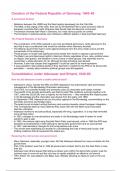Creation of the Federal Republic of Germany, 1945-49
A permanent division
- Relations between the USSR and the West rapidly developed into the Cold War
- The West, at the urging of the USA, then set up the Marshall Plan to give economic help to
European countries that might otherwise take Soviet help and become communist
- The tension showed itself most in Germany, for it had obvious points of con ict
- The formation of political parties soon followed a di erent pattern in East and West Germany
The Federal Republic of Germany
- The constitution of the FRG outlined a very free and liberal democracy, while allowing for the
fact that it was a constitution that would be rewritten when Germany reunited
- The Weimar government had to work against pressure from the army, trade unions and the
monarchists of the aristocracy
- These groups no longer had signi cant power bases from which to oppose a government
- The Basic Law promised equal rights to German citizens regardless of sex, race, political views
or religion; free speech, the freedom to form unions or other groups, free assembly and no
censorship; a state education for all, although private schooling was allowed
- However, it also had clauses that suggested it could be used to be more repressive
- It was possible to ban political parties if they seemed to undermine the FRG or its democratic
principles — anxiety about extreme political groups was still apparent
Consolidation under Adenauer and Erhard, 1949-65
How far did Adenauer create a stable political base?
- Adenauer’s critics, namely the SPD and FDP, objected to his authoritarian style and forceful
management of the Bundestag (Chancellor democracy)
- Until 1955, he controlled foreign and domestic policy as chancellor and foreign minister
- The bene t of his forceful personality was that he kept FRG coalitions working together until
1957, when the CDU/CSU won a majority for the rst time — they remained the majority party
in the Bundestag and the chancellor was always from this party until 1969
- In September 1949, Adenauer set out his policy agenda in the Bundestag, concentrating on the
domestic economy and foreign policy
- The goals he set included uniting Germany and working towards closer European integration
- This contradicted itself as many deemed that closer ties with the West would hold back
German uni cation
- Adenauer worked to exclude political, especially left-wing, opposition, in a way that reminded
some of Nazi policy
- In 1953, changes to vote allocations and seats in the Bundestag made it harder for small
parties to gain a seat
- In 1952, the extreme right-wing Socialist Reich Party was banned, while in 1956 the KPD was
declared unconstitutional in their attitude to democratic government and so was banned
- In 1957, seat allocation changed to limit small parties even more
- The moves were stabilising but resulted in a Bundestag that was a three-party house, with
shifting coalitions that all supported the status quo
Restoring the civil service and government
- Many Germans, especially younger ones, felt that Adenauer allowed too many ex-Nazis into the
government
- Part of the problem was that in 1939 all government workers had to join the Nazi Party or lose
their job
- Adenauer and others argued that letting ex-Nazis work within the democratic system was the
quickest way to move on and the only way to rapidly establish an e ective civil service
- 1951 Article 131 was added to the Basic Law, o cially allowing ex-Nazis to work in the civil
service
fi fi fi ffifi ff ff fl




